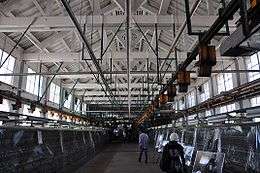Tomioka Silk Mill
Tomioka Silk Mill (富岡製糸場, Tomioka Seishijō) is Japan's oldest modern model silk reeling factory, established in 1872 by the government to introduce modern machine silk reeling from France and spread its technology in Japan. The factory is designated by the government as a historic site and all its buildings are preserved in very good condition. It is a big factory in the old city of Tomioka, in Gunma prefecture, Japan — about 100 km northwest of Tokyo.
| UNESCO World Heritage Site | |
|---|---|
 | |
| Location | Gunma Prefecture, Japan |
| Part of | Tomioka Silk Mill and Related Sites |
| Criteria | Cultural: (ii), (iv) |
| Reference | 1449 |
| Inscription | 2014 (38th session) |
| Area | 5.5 ha (14 acres) |
| Buffer zone | 151.1 ha (373 acres) |
| Website | www |
| Coordinates | 36°15′19″N 138°53′16″E |
 Location of Tomioka Silk Mill in Japan | |
History
Soon after the Meiji Restoration in the late 19th century, the Japanese government hastened the modernization of Japan to catch up with European countries. Japanese raw silk was the most important export and sustained the growth of Japan’s economy at that time. During this boom, however, the Japanese silk industry began to sacrifice the quality of its silk for quantity, which rapidly harmed the reputation of Japan as a raw silk manufacturer. As a result, the national government decided to establish the Tomioka Silk Mill as a model filature facility equipped with the most sophisticated machinery to improve the quality of raw silk.
In 1870, Paul Brunat, who worked in a French trading company in Yokohama, researched suitable locations for a silk mill in the Kantō region and selected the site in Tomioka City from among the candidates.
The construction began in 1871 and was completed in July the next year. Three months later the factory started operation. In the beginning, there were 150 silk reeling machines (300 basins), and about 400 female workers operated the machines in the mill. The lifestyle of the workers has been recorded in the diary of one, Wada Ei.
Tomioka Silk Mill concentrated on offering high-quality raw silk. But even though their silk enjoyed a good reputation overseas for its high quality, the business was always in the red. Even after reducing costs, they continued to suffer from chronic deficits. As a result, the government decided to privatize Tomioka Silk Mill and transferred its business to the Mitsui Finance Group in 1893. In 1902 it was transferred again, from the Mitsui Finance Group to the Hara Company.
In 1939 (the 14th year of the Showa Era), Tomioka Silk Mill was transferred to Katakura Industries Co., Ltd, the largest silk reeling company in Japan. The mill contributed actively to the growth of Japan’s economy during and after World War II. Tomioka Silk Mill was closed in March 1987, and it is well looked after as a historic site.
In 2005 Tomioka Silk Mill was designated by the government as a historical site and was transferred to Tomioka city, and was added to the World Heritage List as a Cultural Site on June 21, 2014.
Gallery
- Inside Tomioka Silk Mill
- Inspector's House
- Dormitory for French Female Instructors
 East Cocoon Warehouse
East Cocoon Warehouse- Infirmary
- Machine
- Silk-reeling Mill
- Dormitory
- Main Building
 Office
Office- Chimney
- Brunat Mansion
See also
| Wikimedia Commons has media related to Tomioka Silk Mill. |